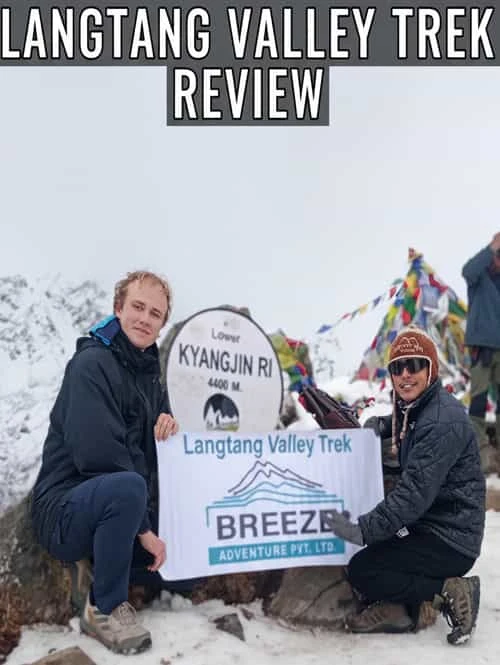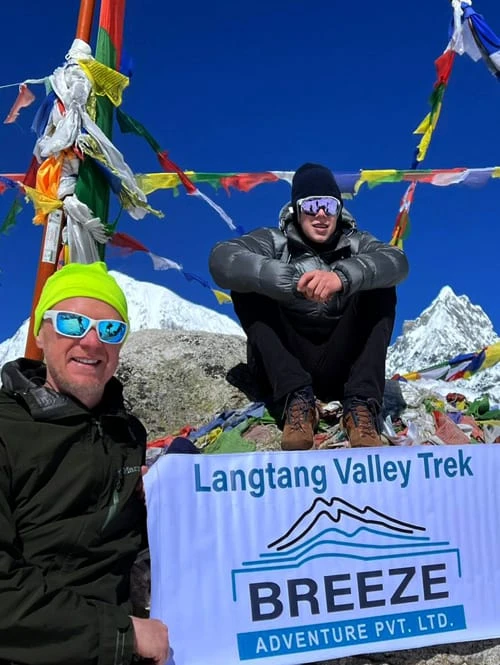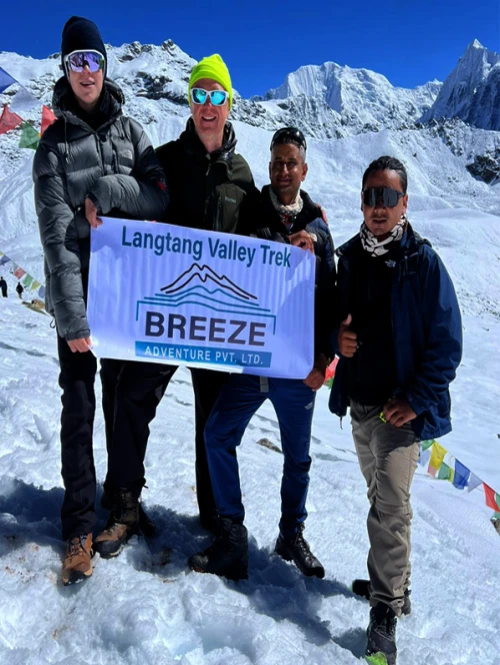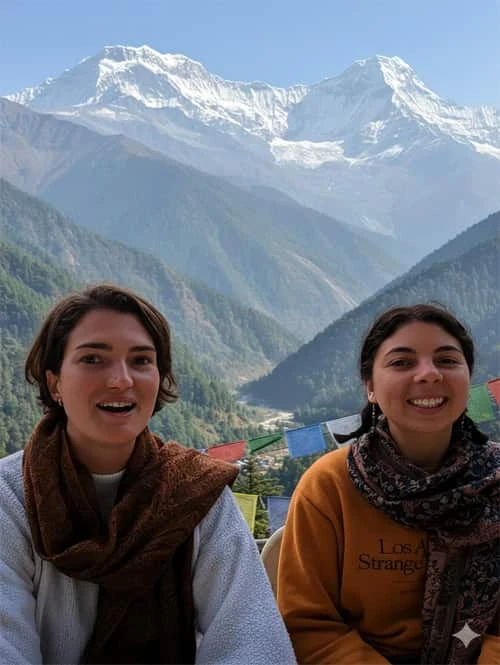Culture Highlights
It is mainly occupied by an ethnic group called the Tamang, who are one of the oldest inhabitants of Nepal. Strongly influenced by Tibetan Buddhism, it seems to have affected them. It has affected their way of life, architecture, and rituals. Which are live testimonies of the past, were handed down. Bright, colorful prayer flags, ancient gompas, and hospitality at tea houses will surely make the trek more meaningful.
One of the holiest places in Langtang Valley is Kyanjin Gompa, a monastery dating back several centuries, located at 3870 meters. This monastery was built as a spiritual center for this region. It is a perfectly decorated monastery with very fine murals and rare scriptures. It also has hand-crafted idols of gods and goddesses from many centuries ago. Other important monasteries along this trail are Sing Gompa, Dukpu Gompa. Each of the gompa's is perfect in providing an ambiance fit for meditation and further following up on cultures.
Beyond the Trail: Unveiling the Hidden Gems
The Langtang Valley Trek is not just a trekking route into the Himalayas. It is a beautiful land, a cultural habitat of the Tamang, and an experience rich in adventure. Unlike other popular treks that become very crowded, Langtang is a calm, clean haven. That offers a genuine sense of wilderness while trekking in Nepal.
A steep valley is situated within the heart of Langtang National Park. It has some beautiful Buddhist monasteries and big glaciers, which are home to a plethora of wildlife. The surprises on the Langtang Trail were continuous at every step. Whether it be a tranquil monastery, a high-altitude pasture, or warm hospitality at Tamang villages.
If you want something that combines natural beauty, cultural diversity, and spiritual peace rolled into one. A trek that you may boast in having been an adventure for a lifetime—just consider the Langtang Trek.
Warm Hospitality of the Tamang People
The people who inhabit the Langtang Valley are from the Tamang community. They are known for their generosity and hospitality nature. The houses are owned mostly by local villagers, hence, trekkers can expect very homely conditions. They grow and serve locally produced food such as Dal Bhat, Noodles. So, tourists might get a very good view of their daily routine, way of living, customs, and folk stories. Interacting with the locals, the visitor gets to learn more about their history and consequently the struggles in their lives. That makes trekking something beyond physical movement.
Traditional Arts and Crafts
The Tamang people are very good at arts and crafts. They have very nice wood carvings, hand-woven clothes, as well as jewelry loaded with intricate designs. The shops on the trails with many souvenirs of handmade goods. These shops are always busy with trekkers and their curiosities, enhancing the beauty of this region.
The 2015 earthquake caused significant damage to the Langtang Valley, but the region has been rebuilt with sustainable tourism practices that promote responsible trekking, minimise environmental impact, and support local communities.
Permits and Other Legalities
For a Langtang Valley trek, one needs to get various permits. It is undertaken to ensure safety and conservation, trekker, and area, and abides by government regulations.
- TIMS Card (Trekkers' Information Management System): A TIMS Card is mandatory for every trekker. It keeps details of trekkers up to date so that they can be rescued in case of an emergency. This can be done in Kathmandu at the Nepal Tourism Board Office.
- Langtang National Park Entry Permit: This trek takes place in Langtang Valley by going through the Langtang National Park. Because of that, it requires an entry permit that costs $30 per person. To raise a sum that may be used toward conservation work and maintenance of trails. This can also be issued in Kathmandu or at Dhunche, the entry point of this area.
- Licensed Guide Requirement: Recently, it was declared by the new government's policy that a trekker must have a licensed guide. Such rules are made for the proper safety and security of the users. This also promotes employment in society at large. These people show trekkers the various routes, cultures, and most importantly, act as savior hands during the emergency.
For a detailed costing breakdown, please have a look at our Langtang Valley Trek cost blog.
Travel insurance is a must for trekking in Nepal. Make sure it covers medical evacuation and high-altitude adventures.
Essential Packing List
Proper gear packing is the most important element that will ensure a safe and comfortable trip across the valley on foot. This is so because, while trekking in the Langtang Valley, the gear inside your pack is quite crucial. As it won't be the conditions. Here is a list of things to carry.
- Trekking Boots and Clothing Layers: The first and most important thing for this trek is to have good-quality trekking boots. The trail is very rocky, with steep inclines and river crossings. This means you need strong, waterproof boots with good ankle protection. If they do not cause blisters or injuries, comfortable, worn-in pairs are best. Other than the boots, it is also going to have appropriate clothes. This is required for drastic changes in weather conditions. Basic layer: a moisture-wicking layer, which will soak away wetness from your skin. An insulating mid-layer, either a fleece or down jacket, for warmth. And an outer layer to guard against worse weather, which should be windproof and waterproof. Also, trekkers tend to wear warm hats, gloves, and thermal socks. This gives an extra feeling of warmth at high altitudes.
- Essential Gear and Accessories: Short break pack (30–40 liters) with water, snacks, and an extra layer of clothes for the day. Trekking poles will help ease the stress on the knees and increase balance on harder terrains. A sleeping bag of a quality that is rated between -10 °C and -15 °C will also be needed. Because overnight camps can get very cold during the night, when on the Langtang Region trek. Other essentials include a headlamp that has extra batteries and a rain cover. This helps keep things in the backpack dry, and a power bank for charging electronic gadgets.
- Personal Care and Safety Essentials: Hygiene and health are very crucial during trekking. A simple first-aid box with band-aids, antiseptic wipes, painkillers, blister pads, and altitude sickness medicine should do. The water to be consumed should be clean, either by using the filtering tablet or through bottled water. Sunscreen, sunglasses, lip balm with SPF, and cream prevent sunburn at these high altitudes. Trekkers should also carry biodegradable soap, toilet paper, and hand sanitizer for personal hygiene.
Preparing for the Trek
Start boosting your fitness a few weeks beforehand, focusing on cardio and building strength. The only things one requires in starting this trek are personal requirements and readiness. Similarly, the right gear and acclimatization are required at high elevations.
- Physical Preparation: The training should begin or start four to six weeks beforehand. Uneven hiking with a backpack to weigh is a good practice that gives trekkers the ability to acclimatize. Strength training is highly recommended, particularly for the legs and core, as it helps enhance stamina and balance. Stretching exercises and yoga help one achieve flexibility. It also increases the ability to keep a proper balance in movement to avoid getting injured.
- Required equipment: In that case, the layering of the thread is very important. It helps the body acclimate to the broad, varying temperatures. Other critical needs are a warm sleeping bag, trekking poles to maintain balance, sunscreen, and sunglasses.
- Altitude Acclimatization Considerations: This is a prerequisite so that people do not suffer from altitude sickness. One is advised to follow meager strategies along with slow, gradual ascent, and the golden rule of climb high, sleep low. Hydration - the more water you drink, the better. Especially as a major solution to the early symptoms of altitude sickness: headache and nausea. When trekkers start to show signs of being at a high altitude. If the symptoms get worse, then the person should immediately go down to lower altitudes and consult a doctor.
- Ideal Time to Visit: This trek is best done through the months of spring (March to May) and fall (September to November). The Langtang trekking trail comes alive with vibrant colors in spring. As rhododendron flowers bloom, and again in September, when a variety of alpine flowers bloom. If you are a flower lover, we recommend visiting Langtang Valley in April, May, August, or September for the most beautiful alpine flowers. It is during these times when the weather is good, hence a clear view of the mountains is available, with the comfort of temperate weather. At that time, monsoon rains were heavy, causing landslides, which even impeded people on their way. Yet, this trek is possible even in winter; it only needs some more preparation against the very cold weather and snow. For the best season to visit Langtang Valley, here is a detailed blog.
- Temperature: The temperature on the Langtang Valley Trek ranges from 10°C to 20°C during the day and 4°C to -10°C at night, depending on the season. Autumn and Spring offer the most comfortable conditions, with mild temperatures ideal for hiking. However, winter can be a bit colder, especially for those new to trekking in the Nepal Himalayas.
Stepping into one of Nepal's prettiest trekking locations should be an opportunity you absolutely should not pass up. Reaching Breeze Adventure will start your extraordinary Himalayan mountain experience.
Responsible Trekking Practices
Practicing responsible trekking in the Langtang region involves respect and conservation of nature. Together with local culture and business. This ensures that Langtang Valley is not lost for future generations to come. Here are some important trekking ethics.
- Leave No Trace Principles: A close second to trekking etiquette is the simple principle of "don't leave trash behind." The trekkers always have to carry out their waste, not spoil the environment, and stay on marked trails. Responsible trekking involves the use of biodegradable products. It also includes the right disposal of plastics and non-recyclable garbage. Open fires should be discouraged, and stoves should be used for cooking.
- Supporting Local Businesses: One should stay in locally owned teahouses and lodges. So that the local economy may be buttressed. Eating regular meals prepared from local products links the farmers. This also gives you the real taste of an authentic meal.
- Cultural Sensitivity: This means proper etiquette to the traditions and customs of Tamang communities living in and around Langtang. Trekkers should be properly dressed. Especially when heading towards a monastery or any religious place. Some local languages like Nepali or Tamang will surely help in good interaction with the indigenous people. Always ask before taking a photograph of a person or his or her possessions, as it could mean a lot in terms of respect.
- Environmental Awareness: Langtang National Park is very rich in flora and fauna. Hence, it should be highly under environmental conservation. Trekkers should not disturb animals, pick plants, or litter on the trails. To keep pollution at the smallest level, one can have eco-friendly toiletries and reusable water bottles. But it's really important to follow responsible ways of water use. Try avoiding unnecessary wastage, as there may be some areas with a limited amount of water resources.
The Langtang Valley trail offers a rich combination of culture, wildlife, and stunning views of the Himalayas, including Langtang Ri, Langtang Lirung, Dorje Lakpa, and many more. The ever-changing landscapes will attract you, making your journey both exciting and deeply fulfilling.









